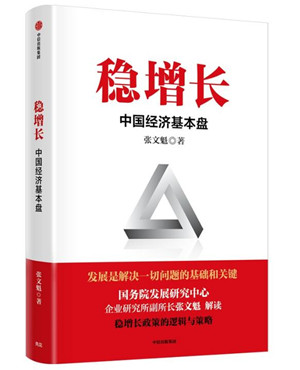
. > WHAT'S NEW > BOOKS
Logic and tactics of stable economic growth
Author : ZHU KELI Source : Chinese Social Sciences Today 2023-03-23

Stable Growth: China’s Economic Fundamentals
Stable Growth: China’s Economic Fundamentals, by Zhang Wenkui, deputy director of the Enterprise Research Institute at the Development Research Center of the State Council, focuses on the implementation of steady growth policies, the growth points of high-quality development, as well as policy challenges and countermeasures.
After experiencing 30 years of high-speed growth following reform and opening up, and relatively robust and stable growth in the following decade, China’s per capita GDP has stood firmly on the doorstep of $10,000. However, this means a new and more difficult start. Moving forward from this step is equivalent to climbing the ladder of growth, which will prove far more challenging than just entering the door of growth before.
In the current context of greater uncertainty in the development environment and greater difficulty in macro policies, it is more necessary to have a batch of indigenous and outward-looking competitive large enterprises to serve as the board of the growth ladder. They help drive industrial upgrading and transformation, and narrow the gap in the total factor productivity with technological frontier countries, achieving high-quality development. In this process, special efforts should be made to support the development of non-resource real sectors to bring industrial innovation. New differentiation is likely to arise in regional economic growth rates, and local competition modes will also undergo major changes. “Industry-inhabitation-innovation” aggregation circles are expected to become a new growth pole.
A few years ago, the IMF warned of the possibility of “growth at risk (GaR).” Amid the COVID-19 pandemic, most countries have implemented ultra-easy monetary and fiscal policies, making GaR a real scenario. Economically, China’s per capita GDP is just over $10,000, and requires a certain growth rate. Meanwhile, it is encountering financial risks brought by debt piling and the pressure of inflation. This brings big challenges for economic policy, particularly in terms of striking a balance.
To seek a balanced economic policy, it is of high necessity to carefully analyze whether financing conditions will change significantly and whether this would trigger financial risks. It should be noted that whether inflation will regress is likely to be an important trigger. The problem is that the new developments likely form a new inflation rather than a classic one.
Modern monetary policy has attracted growing attention all over the world. Former President of Harvard University Lawrence Summers once borrowed the term “voodoo economics” used for describing Ronald Reagan’s tax reduction policies 30 years ago, and called modern monetary theory and the policies it advocates new voodoo economics. The debt problems it incurs add to policy uncertainty.
Zhu Keli is the founding director of the China Institute of New Economy.
Ye Shengtao made Chinese fairy tales from a wilderness
Ye Shengtao (1894–1988) created the first collection of fairy tales in the history of Chinese children’s literature...
-
How northern ethnicities integrated into Chinese nation
2023-09-18
-
Mogao caves
2023-09-12
-
Mogao Grottoes as ‘a place of pilgrimage’
2023-09-12
-
Time-honored architectural traditions in China
2023-08-29
-
Disentangling the civilizational evolution of China
2023-08-28
-
AI ethics in science fiction
2023-08-23













 2011-2013 by www.cssn.cn. All Rights Reserved
2011-2013 by www.cssn.cn. All Rights Reserved